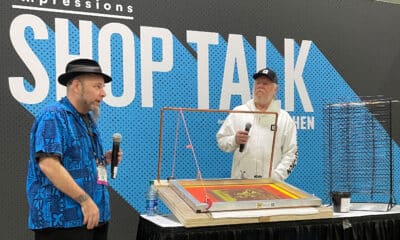Prepress & Screen Making
Published
11 years agoon
The advantages of standardizing the screen-printing process are enormous when looked at on a weekly and monthly basis. All of the seemingly small time savings add up to big rewards as the months go by. The hardest part can often be just getting started, and then the challenge becomes focusing on what to standardize within the printing process that will yield the best results.
The advantages of standardizing the screen-printing process are enormous when looked at on a weekly and monthly basis. All of the seemingly small time savings add up to big rewards as the months go by. The hardest part can often be just getting started, and then the challenge becomes focusing on what to standardize within the printing process that will yield the best results.
In addition to saving time by creating a more efficient process, a screen printer can achieve higher levels of detail by clearly understanding the variables inherent to the print, no matter how complex. To achieve more detail and improve print quality, think backwards instead of forwards in regards to screen printing. In other words, it can be easier to work with a shop’s existing process in printing, screens, and artwork than trying to revamp the entire process from the beginning.
A careful review of a printed shirt with a specific test image will tell you all the vital information you need to then go backwards through your process and start to apply standardization techniques. Often, some simple tweaks to a couple of areas can yield big advances in a print shop’s ability to control details during a print run.
A common barrier to this process is more about attitude than shop processes. Printers, artists, and support staff reach a level of comfort in knowledge and methods they use repeatedly, and it can be an uphill battle to consider new techniques. Extra steps, no matter how important, can be viewed as a burden when the whole issue isn’t considered or when the department in question is viewed as doing something wrong or less efficient than ideal.
A good way to approach the implementation of higher standards is to involve everyone in the overall process and goal setting so that they understand how their effort will help with overall print quality. One example of this is to show how having the tension on every screen clearly marked after reclamation aids the screenmaking department in choosing the right screens for higher quality jobs. Everyone can then understand the necessity of marking tension on every screen.
If possible, show a visual example—one that presents the difference between a print on a poorly tensioned screen and the results on a properly tensioned one. such demonstrations are better motivators than simly talking about the issue.
Establishing process practices
To make rapid headway in standardizing your screen-printing process, first establish clear process practices for each department and put these into an internal manual for each area. Divide the sections into Art, Screens, Setup, Printing, etc. This new manual will help to create an environment where the specific tasks can be isolated and improved in the future.
The next stage is to create printed tests to show the current level of detail and printing capacity for improving detail based on the results. The easiest thing is to first go through and test print a gradient selection on your main mesh types using a specific pattern that is the most common for your shop (Figure 1). You can then assess the current print quality that a typical halftone gradient possesses and make determinations on necessary adjustments to reach optimum print quality.
An important point here is that the tests suggested in this article are for garment screen printing using plastisol ink. A typical print with plastisol ink will maintain the highest quality with the lowest level of printing pressure that releases the ink from the screen stencil onto the garment. In a water-based or solvent-based print, the pressure may need to be considered differently, depending upon the finished product. For water-based inks, more pressure may be necessary to ensure proper penetration into the fibers of the garment.
Once the basic dot-gradient print is done, then adjustments can be made to create optimal printing pressure. Depending on the visible results in the printed piece, adjustments may need to be made to the pressure, angle of the squeegee, ink viscosity, screen tension, and press, screen, or squeegee level. A very common result is to see tonal compression in the printed result of a halftone gradient (Figure 2). Tonal compression happens when the small dots that are created through a stencil halftone start to bleed together due to excessive printing pressure. The appearance of the printed gradient becomes overly dark and the 100-70% halftones blend together and look solid.
If a screen-printing shop is relatively new, it can be very helpful to have an experienced printer or industry veteran to help troubleshoot the process and quickly decide what variables should be adjusted to achieve the ideal print result.
A quality halftone print should display clear dots and solid coverage of the black areas while maintaining a distinct differentiation between the different levels of gray in the printed image. Test the different mesh counts to see which process variables will have to change to accommodate different thread counts. If the shop owner doesn’t want to invest in screens for every mesh to test, then at least test the most common underbase and top-color mesh counts in regards to detail printing (common underbase mesh counts are 140-160 threads/in. and common top color mesh counts are 230-305 threads/in.).
Printing standards beyond halftones
Once the halftone-gradient test standards are determined and a screen printer has a good idea what their best resolution, pressure, ink, and screens are, they can move on to test other variables in the printing process that can help with overall efficiency and eliminate costly scrap shirts.
Registration and trapping-distance test This process will show how well a printer’s equipment can maintain a print on all of the different platens available, as well as during a print run. A review of this two-color print test should show any glaring issues, and especially be noticeable if the automatic press is out of level (Figure 3).
The registration on a press may be problematic on an unlevel platen and sometimes may be different on each press head. Another issue is that a press that isn’t level will print some platens well or too dark and then others too light, or a specific platen that isn’t level may have a print that starts dark and then becomes lighter at the end of the print.
Testing halftone index dots Assuming that everything is acceptable from the rag-and-trap test, the printer can then move onto testing different types of halftones, such as index dots, to determine the highest resolution they can hold effectively for that style of printing (Figure 4). The advantage of using index dots is that with certain types of artwork, the square dot of an index halftone will maintain more printed surface area and retain some small details. Despite a grainy appearance, square dots can actually be very friendly to separate quickly and print well without a lot of dot gain during a longer print run.
Additional dot styles can always be tested as well, and these can be a great way to boost creativity and give a unique look to printed values. Some popular styles of alternative halftones include lines, mezzotints, wavy lines, and etch-tone looks using filters or generated halftone overlays in Photoshop (Figure 5).
The different value tests can then be compared to the original halftone test to see which styles hold the best clarity and tonal differentiation between the different value ranges. A group of standards can be created from that comparison for using halftones depending upon the style and complexity of artwork that’s requested.
Standardizing inks and colors
A great way to save money and increase production efficiency is to push for a standard ink list that all orders should shift to unless the job requires a special-order ink. The easiest way to implement this is to suggest the nearest stock ink during the sales process. That way, the client is encouraged to use an ink that is readily available with the payback being less downtime and ink waste than with special mixes.
Having to mix inks is inevitable, but it doesn’t have to be a standard practice for most orders. The time saved by standardizing and suggesting a stock ink can be a huge benefit to everyone involved in the production because the savings is in multiple areas.
The biggest area of savings is, of course, in labor, but there is also a savings in ink components, containers, and tin waste from leftover inks that are rarely, if ever used again. Even if a printer does not want to implement a custom-mix charge for matching a PMS or specific color, there is a big benefit in pushing a standard inkset to all sales in an attempt to lower the percent of inks that need to be mixed on an average sale.
A good starting set of inks for a screen printer could be around 25 separate inks. This simple set would include some variations of primaries, secondaries, and flesh, wood, and gray-tone inks. Depending upon an experienced printer’s client base, there will likely be additional inks that will need to be added to the list.
A final note on ink standardization is that screen printers who have been around for a long time tend to build quite an ink inventory, and it is unlikely that they will be quick to throw away inks that are mixed. In a short period of time after implementing a stock inkset, even a printer who has a big inventory can eliminate a large amount of ink and free up space that hasn’t been available for screens or other items. A good way to do this is to mark all the inks with a date of their last use and then put hash mark every time they are used after this date. If the ink doesn’t get a mark after six months, it can be put on the recycle list.
Combining tests to advance quality
The true power of standardization in several areas of a company can be seen when they are then leveraged together to produce results that can lift the simple printer to the next level. A screen printer who is willing to get a clear handle on the halftone screen-printing process can then combine these results with a standard ink list to create an art guide that displays how the inks can be stretched and combined to produce as many colors as possible using simulated processes. This guide will allow for a new level of detail and vibrant color reproduction with the lightest print possible on dark garments.
The original gradient test can be printed with stock inks on a dark background with and without an underbase to display the colors that will be produced through a higher level of separation (Figure 6). Once this guide is created, a skilled separation artist can recreate very complex separations for the printer with a high success rate on press because they already know what colors they will get when they execute the final print. Without this process guide, the separations present somewhat of a guess as to how they will come out and the redo rate on final separations, including costly press downtime while the printer waits for revised screens. Only when both areas of standardization are achieved can the real benefit of this process guide be realized and used to its greatest extent.
Once the standards of any of the screen-printing process have been refined to produce the best possible quality, the efficiency and profitability of production will naturally increase.

Subscribe

Magazine
Get the most important news
and business ideas from Screenprinting Magazine.
Most Popular
-

 Columns1 month ago
Columns1 month ago8 Marketing Mistakes Not to Make When Promoting Your Screen Printing Services Online
-

 Press Releases1 month ago
Press Releases1 month agoSports Inspired Clothing Market: The Influence of Sports on Fashion Forward Looks
-

 Editor's Note1 month ago
Editor's Note1 month agoLivin’ the High Life
-

 Marshall Atkinson1 month ago
Marshall Atkinson1 month agoHow to Create a Winning Culture in Your Screen-Printing Business
-

 Press Releases4 weeks ago
Press Releases4 weeks agoHope Harbor to Receive Donation from BlueCotton’s 2024 Mary Ruth King Award Recipient
-

 Case Studies1 month ago
Case Studies1 month agoScreen Printing for Texture and Depth
-

 News & Trends2 months ago
News & Trends2 months agoWhat Are ZALPHAS and How Can You Serve Them in Your Print Business?
-

 Headlines1 month ago
Headlines1 month agoLive Poster Printing Raises $30K for Charity




